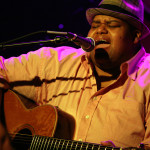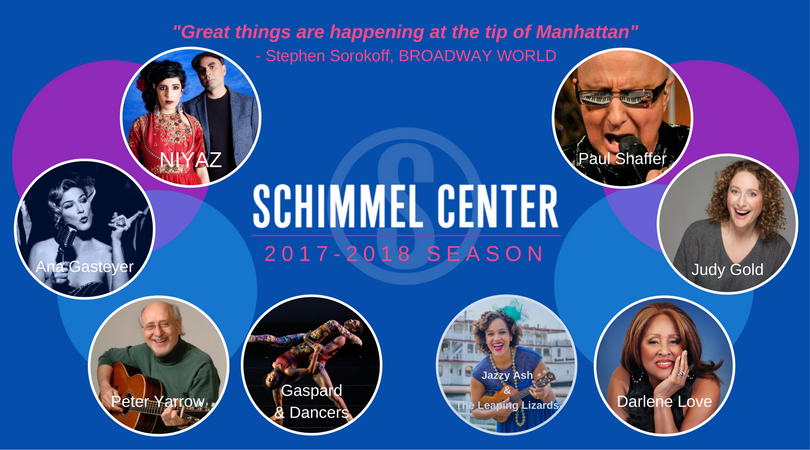An Interview with LaRonda Davis: Inside the Deep Roots of Rock and Roll
On Saturday, November 23, the Black Rock Coalition Orchestra will take the Schimmel Stage under the musical direction and design of the superlative Toshi Reagon. The group assembles some of the greatest living black rock legends of our time to celebrate the “Deep Roots of Rock and Roll.” Today, Pace Presents’ blogger, Michael Torbet, is checking in with LaRonda Davis, President of the Black Rock Coalition, to give our readers a greater sense of what to expect from this momentous event.

The incomparable Toshi Reagon serves as the Artistic and Musical Director of “Deep Roots of Rock and Roll”
MT: Hi LaRonda. Can you first, give our readers a brief history of the Black Rock Coalition?
LD: Hi Michael. Of course. The Black Rock Coalition (or BRC) was founded in New York City in 1985 on the lofty idea that African-American artists, who had contributed so much to American music and culture, had as much right to succeed in the music industry as their White counterparts. Vernon Reid, Konda Mason and Greg Tate, with the Do-It-Yourself spirit shared by countless pioneers before them, organized a group of like-minded, culturally-active folk and set about challenging the market constrictions that attempted to limit progressive artists of color and too-narrowly define the audiences that would encourage, support and sustain their careers. We’re the only national, non-profit, member-supported, volunteer-run organization 100% dedicated to the complete creative freedom of the best and brightest in progressive Black musicianship. Basically, we’ve been in it for the love (and the truth) for the last 28 years.
MT: You sure have assembled an All-Star, legendary cast of musical artists for this event. How did you go about doing this?
LD: The BRC Orchestra has been the official performance arm of the Black Rock Coalition since the beginning. The way it works is: we pick (or a venue commissions us to perform) an important canon of work. We then agonize over the perfect person to coordinate the musicians, flow, and set list to best bring that material to life for the audience. In this case, Toshi Reagon was the one. She’s perfect because, in her own work, she personifies the evolutionary arc of African-American music. Folk. Spirituals. Blues. Roots. Soul. Rock. Alternative…Toshi can nail them all. And everything she puts her voice to pays homage to the legacy of her ancestors. Because of this she has, not only our respect, but the respect of the amazing artists she’s assembled for this show. It’s really a testament to Toshi, the concept, and the BRC’s reputation that this show has shaped up as it has.
MT: I understand that one of the goals of this event is to build a bridge between the artists who started this movement of rock and roll and the artists who carry on their legacy today, such as the ones who will be performing on our stage. How does this event go about doing this?
LD: Well, the material is like a gateway. Everyone loves Chuck Berry, Muddy Waters, and Tina Turner. But what about the next great artists whose names you may not know? It makes it easier for people to discover Toshi Reagon or KimberlyNichole or Marc Anthony Thompson or Karma Johnson or Tamar-kali when they can see them in the context of something more familiar. The hope is that then they start to follow today’s artists and support them in their own original expression. It’s a way to connect historical significance to tomorrow’s musical evolution. It’s part of what the BRC is all about.
MT: There is a social justice issue at the very core of this event. During the mid 20th Century, Rock became disassociated from its African-American roots. Can you describe this situation to our readers? Specifically, what role did marketing and radio DJ’s play in this issue?
LD: Well, Alan Freed is credited for creating the term to describe the music he was hearing from Black artists. But Black musicians of any caliber were not often welcome into mainstream homes in ‘50s and ‘60s America. So, while the music was clearly very powerful, no one really wanted to give Black folks that kind of power (or money). So Sun Records found Elvis Presley and demonstrated to the world that the style of music Black folk had created was indeed viable but, with a new lip-curling White face, could be ‘acceptable’ too. And very profitable. It was in the industry’s best interest to give consumers what they clamored for. Teenage girls could scream for Elvis, but if they screamed for a Black man he was likely to land himself in jail (ask Chuck Berry about the Mann Act). It seems that in the eyes of the powers that were, sexually-charged rock and roll had to be dissociated from Blackness. Payola made it easy for record labels to pull the two apart—playing the White artists’ versions of songs originally performed by their Black counterparts. Following this, Rhythm and Blues formats became the safe home for Black artists and Rock formats played primarily White artists. So, in order for Black artists to find success, they had to easily fit the format. Soon, like most forms of conditioning, the audiences started to make distinctions based more on race than music. We were used to hearing Black artists sound one way and only one way. And over time, R&B and soul actually became part of Black pride and identity. Rock was now considered White because we’d been told it was White. Even now, you can usually find Tina Turner and Prince in the R&B section of the few record stores that still exist. It’s all just proof that, even 50 years later, the blues roots of rock are buried deeper than ever.
MT: Do you think the “British invasion” had any play in this disassociation?
LD: Absolutely. Countless British artists modeled their sound after African-American blues and jazz artists. The Rolling Stones, The Beatles, The Kinks, Led Zepellin all freely admit what they owe to artists like Muddy Waters, Howlin’ Wolf, Little Richard, etc. But because of race relations in the United States, those influences were downplayed and what resulted was the swagger of the blues without the heft of the experiences that created it. After that, the mop-tops and friends had carte blanche to evolve their sound in very public, very well-funded view while the people who inspired them were left to the Chitlin’ Circuit, financial obscurity, and race-based marketing.
MT: Can you tell us a little bit about how this concert will explore this issue?
LD: This concert will start in the fields, call and response, gospel, and blues, to establish the foundation of early rock. Throughout it all, Carl Hancock Rux will guide us through the societal conditions that gave rise to each stage of musical development. Around the halfway point there will be a foray into the British Invasion and how that reshaped the identity of rock and roll when it came back across the pond. From that point on, we’ll be showing how African-American artists have been attempting to reclaim our right to rock ever since.
MT: Who is your personal favorite rock artist and how did they shape the landscape of Rock and Roll?
LD: I, of course, have a maaaaany. But since I’m a child of the ‘80s, I’ll narrow it down to Prince, Living Colour and Nina Simone. Prince, because he was the first Black rock star of the video era. While everyone knew and loved Jimi Hendrix, we didn’t have the benefit of having his brown face on TV every hour on the hour shredding his guitar. Prince gave us that. Living Colour, because they were a Black rock band—each one stunningly skilled at his instrument and undeniable in their solidarity as a collective. They showed that Black people rocking wasn’t an anomaly—here you had four guys on the same wavelength to express themselves through rock and it was massive. Lastly, Nina Simone because she was just a bad-ass. If she were White, there would be no question she was rock and roll. Because of the color of her skin, people disregard her range. But I contend that because she tapped into the roots of her Blackness in whatever genre she chose, she transcended categorization. And the BRC shares my belief that all musicians of color should be afforded the same latitude.
MT: Thank you very much for your time, LaRonda! We look forward to the concert!
“Deep Roots of Rock and Roll” features Vernon Reid, Nona Hendryx, Corey Glover, Marc Anthony Thomas aka Chocolate Genius, Matt Whyte, Tamar-kali, Kimberly Nichole and Jason Walker
For tickets visit schimmel.pace.edu or call (866) 811-4111
The Deep Roots of Rock and Roll/ Black Rock Coalition/NewYork Premiere/ Saturday, November 23rd? 7:30pm/$35
See you at the Schimmel
Michael Torbet
2013-14 Pace Presents’ Blogger

